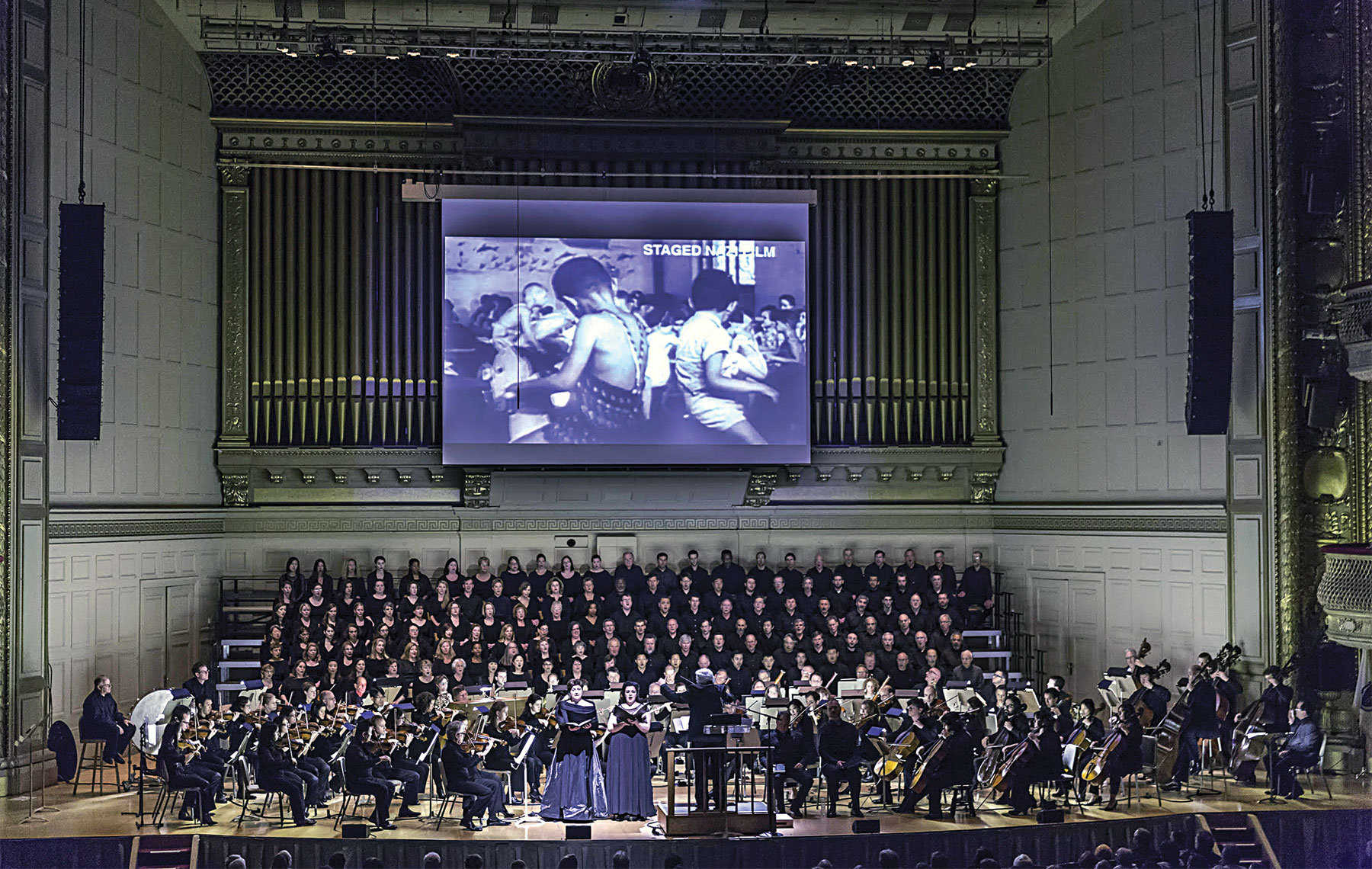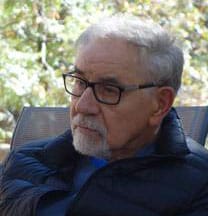
In 1943-44, at Terézin, a hybrid ghetto/concentration camp in the Czech Republic, 150 Jewish prisoners, led by a remarkable conductor, sang Verdi’s “Requiem” as a private act of defiance against the Nazis.
Two separate performances of “Defiant Requiem: Verdi at Terézin,”— on April 16 at Segerstrom Concert Hall in Costa Mesa and on April 17 at UCLA’s Royce Hall — paid homage to those prisoners and to Rafael Schächter, the man who led the choir at Terézin, where the Nazis imprisoned many Jewish cultural figures, including classical musicians.
“Defiant Requiem: Verdi at Terézin,” which has been presented nearly 50 times around the world, performs Verdi’s Christian funeral mass in its entirety. The music is intercut with film clips, narration and taped testimonies from survivors. Much more than a concert or musical event, it’s a soul-wrenching testament to the power of maintaining one’s humanity in the most inhumane circumstances.
In a phone interview with the Journal, Murry Sidlin, 78, who created, crafted and conducted “Defiant Requiem,” said that 25 years ago, when he was conductor of the Minneapolis Symphony Orchestra, he wandered past a table of used books. “I walked over and pulled a book from the middle. It was sticking out, almost beckoning me,” Sidlin said. “It was called ‘Music in Terézin.’”
The book, by Joža Karas, deals with music and the Holocaust. Sidlin was drawn to it because he is a noted orchestra conductor and music educator, and his grandmother was killed during the Holocaust.
“That book is about musicians at Terézin,” Sidler said. “I opened the book at random to a chapter called ‘Rafael Schächter.’ It said he had grown up in Romania and had excelled in music. In the last paragraph, it said that [at Terézin] he put together a volunteer choir of 150 singers and taught them Verdi’s “Requiem” by rote, because there was no score other than his own, and they performed it 16 times between September 1943 and June 1944.”
“The general state of things at Terézin was just insanity and chaos. And in the midst of all this, this guy, [Schächter], put together performances of the Verdi ‘Requiem?’ ” — Murry Sidlin
Sidlin knew the “Requiem” required an orchestra, double-size choir and four operatic soloists. When he read it had been performed at Terézin, Sidlin found it hard to believe.
Soon after finding the book, Sidlin left Minneapolis and became conductor of the Oregon Symphony in Portland. While there, he continued to pursue Schächter’s story. It soon became clear to Sidlin that Terézin’s reputation as a model concentration camp was Nazi propaganda. There was a Jewish Council of Elders that oversaw cultural events, but the council was a tool of the Nazis. Prisoners were allowed to wear civilian clothes with a Star of David insignia, as in the ghettos, but Terézin inmates faced the same conditions as prisoners in other concentration camps: little or no food, slave labor, illnesses including typhus, and constant fear of sudden violence and death.
“The general state of things at Terézin was just insanity and chaos,” Sidlin said. “And in the midst of all this, this guy, [Schächter], put together performances of the Verdi ‘Requiem?’”
Sidlin contacted historians and they put him in touch with Edgar Krasa, who had been Schächter’s bunkmate at Terézin. Sidlin flew to Boston, where Krasa lived, and spoke with him for hours. Krasa, as it turned out, was one of Schächter’s first recruits for the choir, and he connected Sidlin to other survivors, witnesses and singers who talked about their experiences.
“The Council of Jewish Elders at Terézin did not want Verdi’s ‘Requiem’ performed,” Sidlin said. “They felt [that performing a Catholic funeral mass] was going to stir up a lot of trouble. There were rabbis at the camp who were very unhappy about this. … The council told Schächter in no uncertain terms that this should not be done, and he told them in no uncertain terms that this was the right thing to do: It’s inspiring, it’s beautiful music and the text is proper and right …”
Sidlin said that Krasa told him that Schächter’s choice of Verdi’s ‘Requiem’ was deliberate: It was because of the text’s coded language. The Latin liturgy talks about Judgment Day: “When therefore the Judge will sit/Whatever lies hidden will be revealed/Nothing will remain unavenged.” Even as they were facing death, the Jews in that choir sang to the Nazis that, in the end, they would be punished. But the lyrics were Latin, so it’s unlikely the Nazis understood.
As members of Schächter’s 150-person choir were deported, he recruited others and the new singers also had to learn the piece by rote. On June 23, 1944, Schächter’s choir, plus its “orchestra” of a broken piano, gave its final performance: this time for the Nazi command escorting a delegation from the International Red Cross (IRC).
After considering several options, Sidlin decided that the best way to pay homage to those inmates and to Schächter would be to create an event that blends musical and theatrical elements. In 2002, conducting the Oregon Symphony, Sidlin presented “Defiant Requiem: Verdi at Terézin” for the first time.
The interspersed narration and survivor interviews tell personal and poignant stories:
“Whenever I sang, my stomach stopped growling from hunger.”
“Singing the ‘Requiem’ made us feel human.”
“This music put us in another world. This was not the world of the Nazis, this was our world.”
“We sang to the Nazis what we could not say to them.”
An occasional train whistle, echoing the trains that took Jews to death camps, is a reminder that the original performance took place in a concentration camp.
And at the end, there’s a slow, mournful rendition of Nurit Hirsch’s melody to the often-sung prayer, Oseh Shalom — a hint that even after such overwhelming tragedy, there is hope for peace.























 More news and opinions than at a Shabbat dinner, right in your inbox.
More news and opinions than at a Shabbat dinner, right in your inbox.